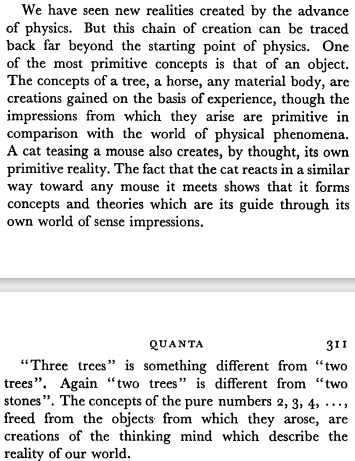-
Posts
5374 -
Joined
-
Days Won
52
Content Type
Profiles
Forums
Events
Everything posted by Genady
-
I don't say or imply anything like that and don't have any idea how it seems so. I say that the states, which are spinors, evolve in spacetime. Just like a scalar such as temperature can evolve in spacetime but is not the same as spacetime. But you don't need to go to spinors to express your concern. Long before Dirac, in the good old Schrödinger equation, the wave functions are complex-valued functions and they represent particle states in a complex vector space. In case of the Hamiltonian observable basis, the states, complex functions, are eigenstates, while the energies, real scalars, are eigenvalues. I don't think there is any problem in this distinction.
-
In the Dirac equation, the evolving objects are spinors. They evolve in spacetime. They constitute states in a spinor space. The equation does not pick any specific basis in this space to expand the spinors as superposition. We are free to choose such a basis and thus such expansion is arbitrary.
-
I refer to eigenstates of any observable. We can expand any state in any basis. This makes the notion of "states in a superposition" arbitrary.
-
Yes, but I refer to a coordinate basis of the space of states rather than the geometric 3D space.
-
Corrections: 1a) The evolution of any quantum state is described by an appropriate equation of motion, such as Schrödinger equation, Dirac equation, and Klein-Gordon equation. The equations of motion are not restricted to "the individual quantum states in a superposition." 1b) Any state is a superposition of some states. Being an "individual quantum state in a superposition" is not property of a state but property of a coordinate basis in which the state is expressed.
-
Which part? [astro-ph/0102033] Value of the Cosmological Constant: Theory versus Experiment (arxiv.org)
-
We can have it the other way around, i.e., zero momentum and infinitely uncertain position, can't we?
-
I've figured out the answer to my question above. It is 12√ψ1+12√ψ2 rather than 12√ψ1−12√ψ2 because when the two wave functions are in phase they interfere constructively, and this requires the + rather than − in their superposition expression.
-
However I don't know why it is \(\frac 1 {\sqrt 2}\psi_1 +\frac 1 {\sqrt 2}\psi_2\) rather than \(\frac 1 {\sqrt 2}\psi_1 -\frac 1 {\sqrt 2}\psi_2\). Any suggestions?
-
Yes, superposition of states resulting from a photon passing through different slits. If the state after passing through slit 1 is \(\psi_1\) and the state after passing through slit 2 is \(\psi_2\), then after passing the screen the state of the photon is the superposition, \(\frac 1 {\sqrt 2}\psi_1 +\frac 1 {\sqrt 2}\psi_2\).
-
I agree. I don't understand the question. But I am sure that you understand my answer. It is not different from, e.g., Fourier transform.
-
My position is that the component states are an expansion of the entire state in a specific basis.
-
If a state is 'in a superposition' or not depends on basis in which it is expressed. The same state is 'individual' in one basis and 'in a superposition' in another.
-
The above ^^^ does not look right to me. Do I understand correctly that "the combination" refers to the "[some expression]"?
-

How can a big bang expand to an infinite size?
Genady replied to Airbrush's topic in Astronomy and Cosmology
Perhaps we will never know. I don't understand this. -
So many possibilities... Maybe the cat was bitten in the past by a person who arrived in a car...
-

How can a big bang expand to an infinite size?
Genady replied to Airbrush's topic in Astronomy and Cosmology
Flatness requires special conditions because it requires the density parameter \(\Omega = 1\), precisely. The other two happen when \(\Omega > 1\) (spherical) or \(\Omega < 1\) (hyperbolic). I don't know how to apply PROBABILITY in the case of one (one universe). I don't know what a problem with infinity is. -
The @studiot's example of counting apples on a tree reminded me of something that I've read too long ago to mention, but thanks to the Internet I could find the quote. It relates to my earlier mention of inventing tools to deal with the world: (from no less than THE EVOLUTION OF PHYSICS BY A. EINSTEIN AND L. INFELD)
-

How can a big bang expand to an infinite size?
Genady replied to Airbrush's topic in Astronomy and Cosmology
An isotropic homogeneous 3D space can have spherical, flat, or hyperbolic geometry. Spherical space is necessarily finite, but both flat and hyperbolic can be infinite. -
Viscosity is a concept that we have invented to deal with fluids. (And, not an easy one to grasp.) Yes. It says that the world is such that these tools work better than those tools.
-
Right. Not necessarily. There are other factors. Not all fish have slender profile. We can. But it will be another tool of us. Yes, we can. It says something. It does not say, what.
-
How can we know this? Here is an analogy. To swim efficiently through water, fish evolved a slender profile. It implies something about the water. But it does not imply that the water has a slender profile. The water even does not have a profile. (To be clear about this analogy, our tools are like fish, the world is like the water.)
-
The space expansion is the one where the clock co-moves.
-
Upon reading it a second time and thinking about it, i would now say a greater yes than before and linearity / non-linearity are properties of the tools rather than of the world.
-
Dimensional analysis does not help you to find out dimensionless factors.


